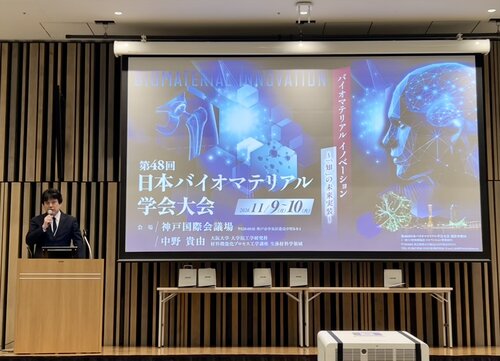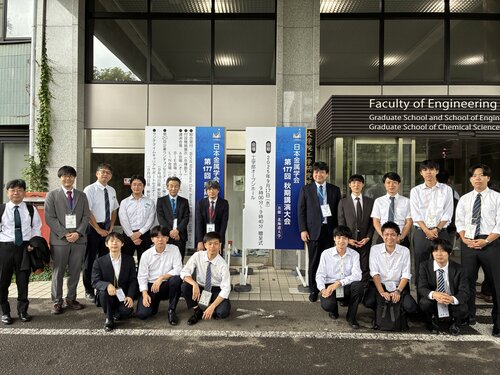最新情報
最新の30件
2025.12.04
【論文】Journal of Physics: Conference Seriesにレーザ粉末床溶融法で作製した β型Ti-Cr 合金における格子欠陥の陽電子消滅分光および第一原理計算による解析に関する論文が掲載されました。
Masataka Mizuno, Ryosuke Takahagi, Ryosuke Ozasa, Takayoshi Nakano, Hideki Araki:
Investigation of lattice defects in β-type Ti-Cr alloys fabricated via laser powder bed fusion using positron annihilation spectroscopy and first-principles calculations, Journal of Physics: Conference Series, 3149, (2025), 012010.
DOI: https://iopscience.iop.org/article/10.1088/1742-6596/3149/1/012010
論文はこちら
PDFはこちら
Abstract
The structure of β-type titanium alloys with a body-centered cubic (BCC) arrangement is stabilized by β-stabilizing elements. In the present study, to clarify the influence of β-stabilizing elements on the stability of lattice defects in β-type Ti-18.7 at%Cr alloys prepared by laser powder bed fusion (LPBF), the as-fabricated samples were subjected to positron lifetime measurements. The positron lifetime of the as-fabricated sample was approximately 20 ps longer than that of the annealed sample, indicating the introduction of lattice defects in the as-fabricated samples. The positron lifetime of the defect component in Ti-18.7%Cr fell between those of vacancies and dislocations, suggesting that both types of defects were introduced during LPBF fabrication. In contrast, in the authors' previous study, no lattice defects were observed in Ti-15Mo-5Zr-3Al, plausibly because of the recovery of vacancies during LPBF cooling. This recovery is attributed to the anomalously fast vacancy diffusion in the BCC β-phase. In the case of Ti-18.7 at%Cr, such vacancy recovery may be inhibited by the presence of Cr atoms, which tend to increase the energy for vacancy formation and migration at neighboring sites.
2025.12.04
【書籍】中野先生と松垣先生が分担執筆した『界面制御による革新的生体適合性材料開発』が2025年12月15日に発刊されます。
高井まどか、三浦佳子、中野貴由、松垣あいら(分担):
界面制御による革新的生体適合性材料開発、株式会社エヌ・ティー・エス、2025年12月15日発刊、ISBN: 978-4-86043-782-4
https://www.nts-book.co.jp/item/detail/summary/bio/20251200_330.html
2025.11.27
【受賞】第19回 物性科学領域横断研究会にて、M2の宮澤君が最優秀若手奨励賞を受賞しました。
レーザ粉末床溶融結合を利用した準安定β型Ti合金の窒素固溶化と高機能化
○宮澤 啓太郎、小笹 良輔、中野 貴由
最優秀若手奨励賞、東京大学、2025年11月27日
2025.11.25
【論文】ElsevierのBioactive Materials (IF=20.3)に水和水に基づく骨組織とハイドロキシアパタイトの接着に関する論文がOA論文として掲載されました。
Shichao Xie, Masahiro Okada*, Haruyuki Aoyagi, Akihisa Otaka, Xiaofeng Yang, Takayoshi Nakano, Takuya Matsumoto*:
Robust adhesion between solid-state hydroxyapatite and bone tissue through surface demineralization, Bioactive Materials, 57, (2026), 632-645.
DOI: https://doi.org/10.1016/j.bioactmat.2025.11.030
論文はこちら
PDFはこちら
Abstract
Objective Current bone adhesives typically lack adequate mechanical strength, long-term stability, or biocompatibility. To address these limitations, we designed a new adhesion strategy using a solid-state hydroxyapatite (HAp) adhesive in combination with bone surface demineralization.
Methods
Solid-state HAp adhesives were synthesized via wet chemical precipitation and heat treatment. Cortical bone specimens were partially demineralized with phosphoric acid (H3PO4) or ethylenediaminetetraacetic acid (EDTA), and characterized using scanning electron microscopy (SEM) and attenuated total reflectance-Fourier transform infrared spectroscopy (ATR-FTIR). Shear adhesion strength of HAp to demineralized bone was measured over time. In vivo fixation was assessed in rats using micro-computed tomography and histology. Statistical analysis used Tukey-Kramer tests after normality and variance checks.
Results
Although the HAp adhesive failed to adhere to non-demineralized bone, effective adhesion was achieved on the surface-demineralized bone tissue. Shear adhesion strength was significantly higher in EDTA-treated samples (238.4 kPa at 10 h) compared to H3PO4-treated samples (102.9 kPa at 1 h), with performance correlating with demineralization depth. ATR-FTIR and SEM analyses revealed that EDTA preserved collagen's triple-helix structure and free water content, both enhancing adhesion. Animal experiments confirmed stable fixation of HAp adhesive to demineralized bone tissue.
Conclusions
Surface demineralization enabled strong adhesion of the solid-state HAp adhesive to bone by exposing collagen swollen with water. Adhesion strength was influenced by structural changes in the demineralized layer, and the adhesive provided stable in vivo fixation, supporting its potential for bone-anchored biomedical applications.
2025.11.19
【論文】ElsevierのBioactive Materials (IF=20.3)に水和水に基づく骨組織とハイドロキシアパタイトの接着に関する論文が受理され、OA論文として掲載予定です。
Shichao Xie, Masahiro Okada*, Haruyuki Aoyagi, Akihisa Otaka, Xiaofeng Yang, Takayoshi Nakano, Takuya Matsumoto*: Robust adhesion between solid-state hydroxyapatite and bone tissue through surface demineralization, Bioactive Materials, accepted, (2025).
2025.11.12
【新聞】日刊工業新聞に、経済産業省による「金属積層造形の普及拡大・活用促進に向けた検討会」の記事が11月11日に、JST-Crestの安田研を中心とした成果が11月12日に掲載されました。
★金属積層造形後押し、経産省産業振興策など検討会、日刊工業新聞、総合2面、
2025年11月11日朝刊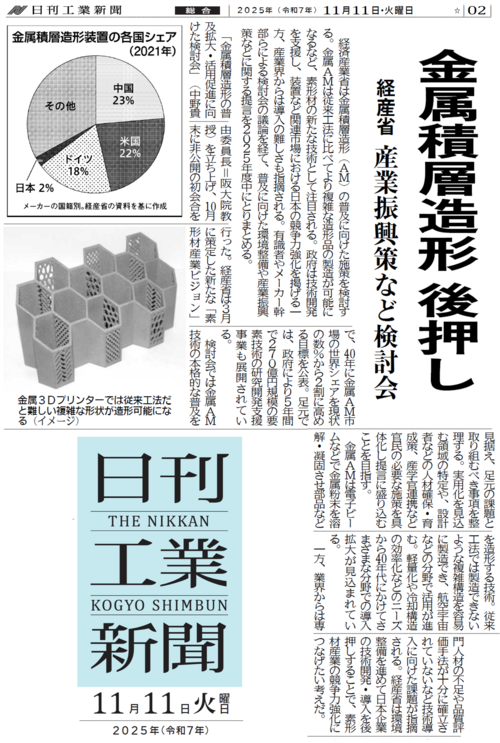
★金属3D積層で高強度、ニッケル基超合金阪大が力学機能制御法、日刊工業新聞、科学技術・大学面、
2025年11月12日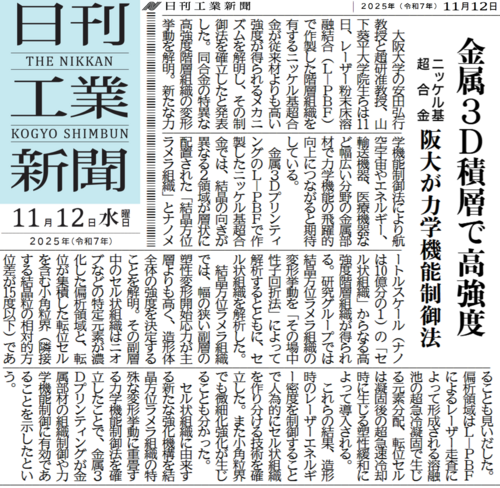
2025.11.12
【委員会】経済産業省による非公開開催の「金属積層造形の普及拡大・活用促進に向けた検討会」の詳細が経済産業省のHPで公開されました。中野先生が委員長を務めています。第一回は2025年10月31日に開催されました。
検討委員会HP→
https://www.meti.go.jp/policy/mono_info_service/mono/sokeizai/AM-WG.html
第一回検討委員会(2025年10月31日)→https://www.meti.go.jp/policy/mono_info_service/mono/sokeizai/AM-WG01.html
★趣旨・目的
積層造形(以下、AM:Additive Manufacturing)は製造業に変革をもたらすと言われてきました。現時点でも、航空宇宙、医療機器、プロトタイプの試作、エネルギーなどの分野で、AMは既に商業的な利用が開始されるなど、AMの利用は拡大しています。
また、経済安全保障の観点でも、AMは、我が国の製造業の優位性、国際競争力を維持するための「ものづくり基盤技術」の一つとして期待されています。
こうした状況を踏まえ、次の点を中心に現状の取組を整理した上で、AMの普及拡大・活用促進に向けて取り組むべき事項に関して検討を行い、具体的な提言を取りまとめる予定です。
AMの価値・可能性
AM人材の確保・強化
AMの技術進展、コスト低減
AMに関する産学連携の強化(地域拠点化を含む)
技術基盤(品質保証・認証制度等)の整備と促進
AMの認知度向上(AM活用事例を含む)
2025.11.12
【学会主催】中野先生が大会長を務める第48回日本バイオマテリアル学会大会のHPが掲載されました。
第48回日本バイオマテリアル学会大会の大会長を拝命し、2026年11月9日(月)~10日(火)の期間、神戸国際会議場(〒650-0046 神戸市中央区港島中町6-9-1)にて開催することになりました。
今回の大会のテーマは「バイオマテリアル イノベーション~「知」の未来実装~」と致しました。使われてこそ"バイオマテリアル"との考えのもと、バイオマテリアルに対して、より高度で精密な機能性の発揮が求められています。バイオマテリアル関連研究者・技術者・臨床家の絶え間ない「知」への挑戦が、より高い次元での社会実装へとつながるものと確信しています。多数の皆様、奮ってご参加ください。
リンク→https://lynx-dent.jp/jsb48/
ポスター→final_48バイオ.pdf
2025.11.11
【論文・プレスリリース】大阪大学から、「金属3D プリンティングに特異な高強度階層組織の変形挙動を解明」に関するActa Materialiaへの論文掲載に関するプレスリリースを14時付で行いました。同時に論文がOAとして掲載されました。JST-Crestの成果です。
Ken Cho, Kippei Yamashita, Shinnosuke Kakutani, Takuma Saito, Taisuke Sasaki, Katsuhiko Sawaizumi, Masayuki Okugawa, Yuichiro Koizumi, Tsuyoshi Mayama, Taichi Kikukawa, Ozkan Gokcekaya, Takuya Ishimoto, Hajime Kimizuka, Wu Gong, Takuro Kawasaki, Stefanus Harjo, Takayoshi Nakano, Hiroyuki Y. Yasuda*: Effect of nanoscale cellular structure on the mechanical properties of Inconel 718 with unique hierarchical structure fabricated by laser powder bed fusion, Acta Materialia.
DOI: https://doi.org/10.1016/j.actamat.2025.121696
プレスリリース原稿はこちら
論文はこちら
Abstract
The deformation behavior and strengthening mechanism of Inconel 718 with a hierarchical structure composed of microscale crystallographic lamellar microstructure (CLM) and nanoscale cellular structure, fabricated by laser powder bed fusion, were clarified via nanoscale microstructural and in-situ neutron diffraction analyses. The CLM is a layered structure parallel to the building direction (BD) and consists of relatively wide main and narrow sub-layers with <110> and <100> orientations, respectively, with respect to BD. This is the first study to demonstrate that the yield stress of the alloys depends strongly on deformation stresses of the sub-layers, even though Schmid factors of the primary slip system for both layers are the same. The sub-layer continues to deform elastically even beyond the micro-yield point of the main layer, which results in the macroscopic strengthening at an early stage of deformation. On the other hand, the cellular structure is formed in both layers, associated with a dendritic cell growth along <100> direction, Nb segregation between the cells and an accumulation of dislocations to decrease a residual stress. The cell boundaries with numerous dislocations and Nb segregation act as a strong barrier to dislocation motion resulting in a stress increase through the Hall-Petch law, even though they are low-angle grain boundaries. The spacing and morphology of the cell boundary depend strongly on fabrication conditions. The optimized cellular structure provides significant strengthening comparable to or greater than that caused by large-angle grain boundaries, thereby increasing the macroscopic strength of the alloys through hardening of the sub-layer.
2025.11.10
【学会】第47回日本バイオマテリアル学会大会(@東京たま未来メッセ、11月10日~11月11日)に参加しました。
【日本学術会議公開シンポジウム】
骨基質配向化デバイスの創製
〇中野貴由
固体表面機能創出・界面バイオ反応制御
〇松垣あいら
【一般講演】
マイクロパターンMPC-Ti材料による骨芽細胞配列を介した機能的骨組織再生
〇松坂匡晃、松垣あいら、石原一彦、中野貴由
薬剤性骨脆弱化における骨基質タンパク質活性制御と骨配向性の変化
〇齊藤光郁、松垣あいら、中野貴由
材料表面形状により配向制御した骨芽細胞・骨基質の抗菌特性発現
〇森陶子、松垣あいら、中野貴由
硬組織に対する多孔質ハイドロキシアパタイトの接着固定
○謝世超、岡田正弘、青柳陽之、大高晋之、楊暁峰、中野貴由、松本卓也
【ポスター】
酸処理チタンと骨との相互作用に関する研究
〇青柳陽之、大高晋之、岡田正弘、中野貴由、松本卓也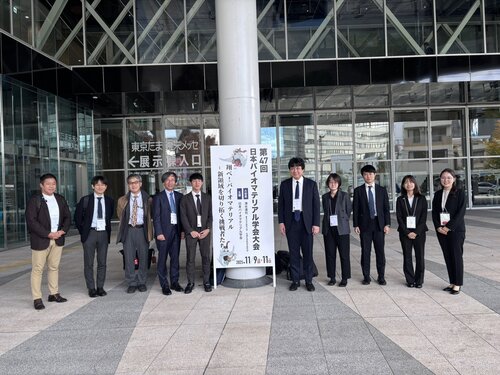
左から関西大 上田正人先生、関西大 岩﨑泰彦先生、東京理科大 菊池明彦先生、大阪大学 石原一彦先生とともに
閉会式では、来年度の第48回日本バイオマテリアル学会大会に向けて、大会長としての決意を述べました。
2025.11.10
【特別講演】中野先生が、日本臨床バイオメカニクス学会第52回学術集会(松田秀一会長・安達泰治会長)にて特別講演をしました。
中野貴由:メカニカルストレスに最適化された骨基質配向性とその誘導のための脊椎スペーサーの開発、日本臨床バイオメカニクス学会第52回学術集会(松田秀一会長・安達泰治会長)、2025年11月8日(土) 9:30~10:00、 特別講演、京都テルサ.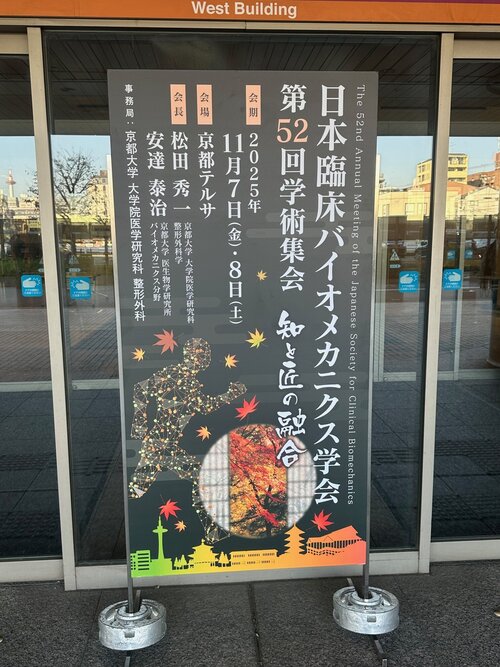
2025.11.08
【招待講演】松垣先生が、日本臨床バイオメカニクス学会第52回学術集会(松田秀一会長・安達泰治会長)にて招待講演を行いました。
松垣あいら、松坂匡晃、中野貴由:骨マトリクス形成における骨細胞メカノバイオロジー、日本臨床バイオメカニクス学会第52回学術集会(松田秀一会長・安達泰治会長)、シンポジウム「運動器の細胞・組織メカノバイオロジー」、2025年11月8日(土)、京都テルサ.
2025.11.07
【論文】経口投与されたリン酸カルシウムによるカドミウム誘発性骨劣化の改善効果に関する研究成果が、Biological Trace Element Research にOA論文として掲載されました。
Ping-chin Sung, Ahmad Bikharudin, Masahiro Okada, Randa Musa, Kenta Uchida, Akihisa Otaka, Tadaaki Matsuzaka, Aira Matsugaki, Takayoshi Nakano, Takuya Matsumoto:
Amelioration of Cd-induced Bone Deterioration by Orally Administered Calcium Phosphate, Applied Food Research, 5, (2025), 101482: 1-9.
DOI: https://doi.org/10.1016/j.afres.2025.101482
論文はこちら
PDFはこちら
Abstract
Cadmium (Cd) is a heavy metal that accumulates in the body, primarily through daily grain intake, and has a high affinity for bone, leading to skeletal diseases such as osteomalacia and fractures. Hydroxyapatite (HAp), a major bone mineral component, is highly pH-sensitive and is known to incorporate Cd, as observed in studies of Itai-itai disease. Based on these findings, we hypothesized that HAp could serve as an effective oral detoxification material for heavy metals. This study investigated the efficacy of orally administered HAp in inhibiting Cd-induced changes in bone physical and chemical properties, comparing its effects to those of activated charcoal (AC), a common detoxifying agent. Six-week-old male ICR mice were exposed to cadmium via drinking water containing CdCl2 and subsequently given diets containing either HAp or AC for four weeks. Three-point bending tests, micro-CT analysis, and histological observations of the femurs demonstrated that mice receiving HAp exhibited improved mechanical strength and enhanced bone quality protection compared to the control and other Cd-treated groups. Activated charcoal also contributed to bone quality improvement at low concentrations, but its effect diminished at high concentrations. These results suggest that the oral administration of HAp may be a promising therapeutic strategy for suppressing cadmium-induced osteomalacia.
2025.11.06
【論文】経口投与されたリン酸カルシウムによるカドミウム誘発性骨劣化の改善効果に関する研究成果が、Biological Trace Element Research へ受理されました。
Ping-chin Sung, Ahmad Bikharudin, Masahiro Okada, Randa Musa, Kenta Uchida, Akihisa Otaka, Tadaaki Matsusaka, Aira Matsugaki, Takayoshi Nakano, Takuya Matsumoto:
Amelioration of Cd-induced Bone Deterioration by Orally Administered Calcium Phosphate, Applied Food Research, (2025), 101482.
2025.11.02
【論文】Ni基超合金の摩耗・腐食特性への組織の影響について、Journal of Materials Research and Technology にOA論文として掲載されました。
Sung-Hyun Park, Fatmanur Ayten, Asli Gunay Bulutsuz, Ozkan Gokcekaya*, Muhammed Enes İlgazi, Hakan Yilmazer, Burak Dikici, Takayoshi Nakano*:
Wear and corrosion performance of textured Hastelloy-X fabricated by laser powder bed fusion: Process window and microstructural features, Journal of Materials Research and Technology, 39, (2025), 6156-6168.
DOI: https://doi.org/10.1016/j.jmrt.2025.10.229
論文はこちら
PDFはこちら
Abstract
This study investigated the effect of volumetric energy density (VED) on the densification and microstructural evolution of Hastelloy-X (HX) alloy fabricated by the laser powder bed fusion (L-PBF) process, and how these changes affect wear and corrosion performance. Variations in VED altered melt pool geometries, which influenced densification. In addition, VED also affected the growth direction of <100> cellular microstructures, resulting in different crystallographic texture development. Specifically, high VED showed the lowest densification with strong <100> alignment in x,y, and z directions. Meanwhile, medium VED exhibited the highest densification with a mixed <100> and <110> crystallographic texture along the building direction, while low VED led to moderate densification with weak <100> alignment overall. The wear and corrosion properties of the samples varied with their densification and microstructural characteristics. In terms of wear mechanisms, a distinct load dependence was observed. Oxidative wear dominated at low loads, where the strong (100)-oriented crystallographic texture promoted oxide stability and improved the wear resistance. While deformation wear prevailed at higher loads, where hardness became the determining factor. As for corrosion resistance, higher densification, grain refinement, and high dislocation density generally facilitated passive film formation and improved resistance. However, crystallographic texture should also be considered, since (100)-oriented regions are more prone to corrosion than other orientations, indicating that the crystallographic texture inherent to L-PBF processing is an important factor in corrosion behavior. The results demonstrate that optimizing L-PBF process parameters is essential for tailoring microstructure and improving the wear and corrosion resistance of Ni-based superalloys.
2025.11.01
【受賞】日本金属学会第8回第7分野講演会にて、M2の清水君、M1の時實君が優秀ポスター賞を受賞しました。
L-PBF法により創製される温度場を介したインバー合金の低熱膨張化
○清水佑太、Ozkan Gokcekaya、小笹良輔、寺井智之、蓮見侑士、大山伸幸、中野貴由
第8回日本金属学会第7分野講演会最優秀ポスター賞、神戸大学、2025年11月1日
下顎骨における咀嚼荷重に応じた三次元的な骨配向性変化
○時實秀和、松坂匡晃、松垣あいら、中野貴由
第8回日本金属学会第7分野講演会最優秀ポスター賞、神戸大学、2025年11月1日
2025.11.01
【学会】中野研究室のメンバーが第8回日本金属学会第7分野講演会「⾦属系バイオマテリアルサイエンスの新展開(Ⅷ)」(@神戸大学、11月1日)に参加しました。
11月1日
ポスター発表
L-PBF法により創製される温度場を介したインバー合金の低熱膨張化
○清水佑太、Ozkan Gokcekaya、小笹良輔、寺井智之、蓮見侑士、大山伸幸、中野貴由
下顎骨における咀嚼荷重に応じた三次元的な骨配向性変化
○時實秀和、松坂匡晃、松垣あいら、中野貴由
2025.10.29
【招待講演】松垣先生が、粉体粉末冶金協会 2025年度秋季大会(第136回講演大会)にて招待講演を行いました。
松垣あいら、小笹良輔、Gokcekaya Ozkan:レーザ粉末床溶融結合法による生体用ハイエントロピー合金の新規開発に関する研究、粉体粉末冶金協会 2025年度秋季大会(第136回講演大会) 協会賞受賞記念講演(研究進歩賞) 九州大学医学部 百年講堂、2025年10月29日
2025.10.28
【論文】Ni基超合金の摩耗・腐食特性への組織の影響について、Journal of Materials Research and Technologyへ受理されました。
Sung-Hyun Park, Fatmanur Ayten, Asli Gunay Bulutsuz, Ozkan Gokcekaya*, Muhammed Enes İlgazi, Hakan Yilmazer, Burak Dikici, Takayoshi Nakano*:
Wear and corrosion performance of textured Hastelloy-X fabricated by laser powder bed fusion: Process window and microstructural features, Journal of Materials Research and Technology, 39, (2025), 6156-6168.
2025.10.16
【招待講演】中野先生が第40回日本整形外科学会基礎学術集会(石橋恭之会長、青森)で招待講演を行いました。
中野貴由:骨配向性に着目した三次元積層造形による脊椎スペーサーの研究開発
共同シンポジウム3「バイオマテリアル研究の実用化へ向けて」(座長:松田秀一先生、京本政之先生)
2025年10月16日(木)10:40-12:10、第6会場(ホテル青森 3F善知鳥)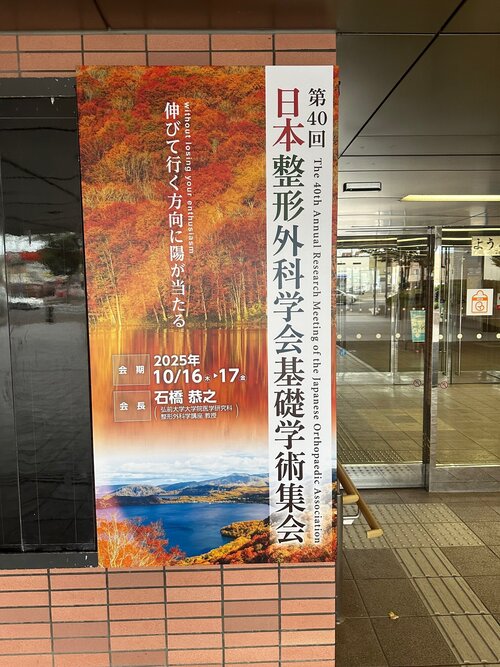
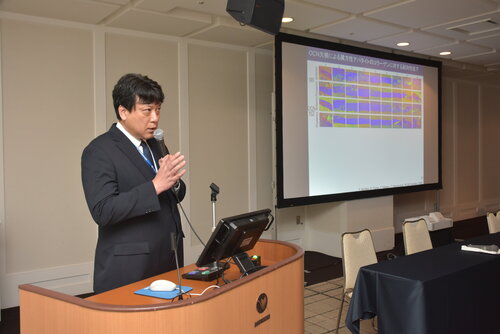
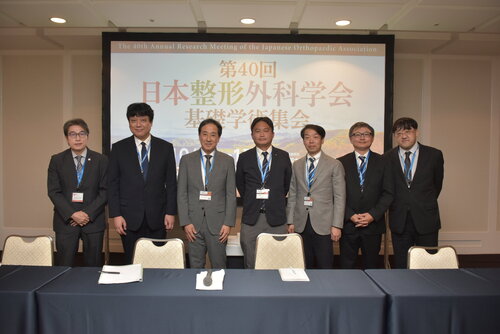
2025.10.09
【受賞】宮澤君が、日本チタン学会 講演大会(2025年度)(直江津)にて、最優秀ポスター賞を受賞しました。
宮澤啓太郎、小笹良輔、中野貴由:
最優秀ポスター賞、L-PBFにおける窒素ガス雰囲気を利用したTi-42Nb合金の高強度化、
第5回日本チタン学会講演大会(2025年度)、日本チタン学会、
2025年10月10日、直江津学びの交流館
2025.10.09
【学会】第5回日本チタン学会 講演大会(2025年度)(@直江津学びの交流館、10月9,10日)に参加し、以下の発表を行いました。
一般講演
〇小笹 良輔、中野 貴由:
L-PBFによるTi基合金の組成に応じた微細組織と力学特性の制御
〇Ozkan Gokcekaya, Takayoshi Nakano:
Design of Bio High-Entropy Alloys with Suppressed Elemental Segregation for Laser Powder Bed Fusion Process
ポスターセッション
〇宮澤 啓太郎、小笹 良輔、中野 貴由:
L-PBFにおける窒素ガス雰囲気を利用したTi-42Nb合金の高強度化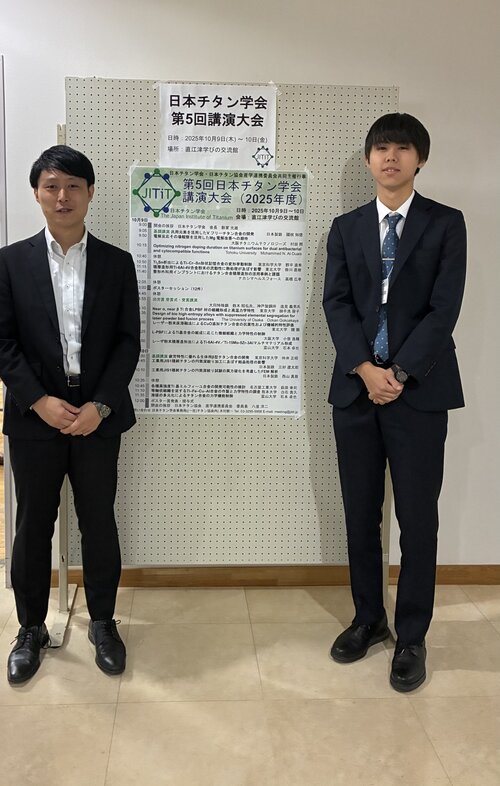
2025.09.29
【講演】中野先生がセラミックス3D積層造形研究会 2025年度第1回研究会にて講演を行いました。
中野貴由先生が、一般社団法人日本ファインセラミックス協会にて開催された「セラミックス3D積層造形研究会 2025年度第1回研究会」において、 「結晶性材料の積層造形による形状・結晶配向性制御と骨医療デバイス応用」 と題したご講演を行いました。
PDFはこちら
2025.09.26
【受賞】日本金属学会2025年(第177回)秋期講演大会ポスターセッションにて、M1の竹下君、M2の内芝君が優秀ポスター賞を受賞しました。
特異な直交性⾻基質配向化制御機構の解明と⽣体組織配向性への影響
○⽵下 恭平、中⻄ 陽平、松坂 匡晃、松垣 あいら、中野 貴由
第45回優秀ポスター賞、北海道大学、2025年9月17日
レーザ粉末床溶融結合を⽤いたTi準結晶の創製と組織解析
○内芝 旭祥、⼩笹 良輔、佐藤 和久、中野 貴由
第45回優秀ポスター賞、北海道大学、2025年9月17日
2025.09.24
【お祝い】中野研究室のメンバーで中野先生の58歳の誕生日をお祝いしました。
2025年9月22日に中野先生が58歳の誕生日を迎えられました。研究室のメンバー一同でケーキを用意し、日頃のご指導への感謝を込めてお祝いしました。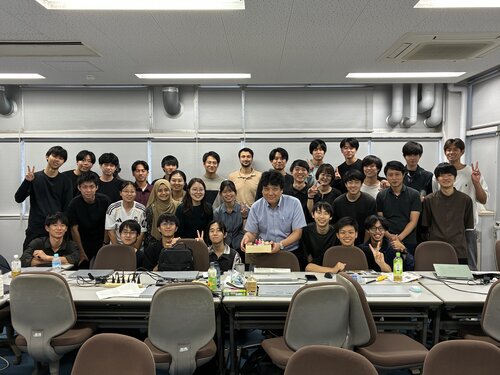
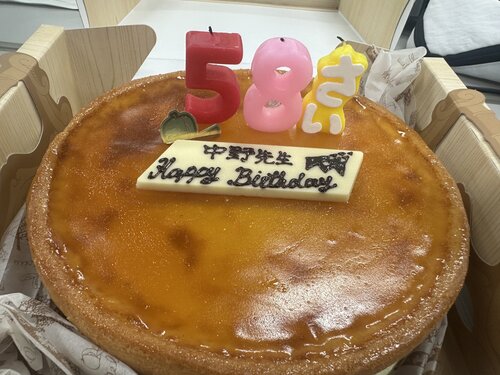
2025.09.23
【論文編集】中野先生がAdditive Manufacturingをはじめとした材料開発と新プロセスに関する新規の論文誌、"Journal of Innovations in Materials and Manufacturing Engineering (JIMME)" の編集委員に就任しました。オーストラリアのScilight Pressから出版され、チーフエディターはテキサス大のProf. L. E. Murrです。
中野先生がAdditive Manufacturingをはじめとした材料開発と新プロセスに関する新規の論文誌、"Journal of Innovations in Materials and Manufacturing Engineering (JIMME)" の編集委員に就任しました。オーストラリアのScilight Pressから出版され、チーフエディターはテキサス大のProf. L. E. Murrです。
AIMS
Journal of Innovations in Materials and Manufacturing Engineering (JIMME) is an international, peer-reviewed, multidisciplinary journal that provides a platform for disseminating high-quality original research and critical reviews in materials and manufacturing engineering. The journal serves both the academic and industrial communities, fostering the exchange oof cutting-edge knowledge and innovations. It aims to highlight contemporary advances and future developments, with particular emphasis on the practical applications of novel materials and manufacturing technologies. It is published quarterly online by Scilight Press, Melbourne, Australia.
Scope of the Journal
JIMME covers a broad range of topics encompassing new materials, processes, and technologies applied to manufacturing engineering and product development, with special focus on innovations in additive manufacturing and related emerging processes. Topics of interest include, but are not limited to:
• Novel materials development, synthesis, applications, and methodologies in advanced manufacturing processes, particularly across the full spectrum of 3D printing technologies.
• Multifunctional material and device design, covering metals and alloys (including high-entropy alloys, superalloys, and superplastic alloys), composite materials, electronic and optical materials, nanomaterials, biomaterials, 2D materials, and other advanced material systems.
• Innovations in materials processing, including hybrid and multi-material manufacturing approaches.
• Characterization, optimization, and simulation of materials and manufacturing processes, with an emphasis on modelling, artificial intelligence-driven design, and digital manufacturing applications
2025.09.17
【学会】日本金属学会2025年(第177回)春期講演大会(@北海道大学、9月17日~9月19日)に参加しています。
中野研究室のメンバー(+名工大萩原教授、富山大松田教授、富山大石本先生、熊本大山崎教授、産総研李先生)で集合写真を撮影しました。
2025.09.17
【学会】中野研究室のメンバーが日本金属学会2025年(第177回)春期講演大会(@北海道大学、9月17日~9月19日)に参加します。
9月17日
〇小笹良輔、中野貴由:
[S5.28] [基調講演] L-PBFにより創製したBCC型Ti含有合金の急冷凝固組織
〇重永 徹平、松坂 匡晃、松垣 あいら、中野 貴由:
[P127] PBF-LB法による高分子材料中の高次組織配向制御
〇山野 大陸、山田 夏子、松垣 あいら、石本 卓也、中野 貴由:
[P129] ヒト頭蓋骨における階層的な異方性骨微細構造の解明
〇竹下 恭平、中西 陽平、松坂 匡晃、松垣 あいら、中野 貴由:
[P312] 特異な直交性骨基質配向化制御機構の解明と生体組織配向性への影響
〇平田 渉悟、小笹 良輔、石本 卓也、佐藤 和久、今野 晋也、石田 清仁、中野 貴由:
[P315] L-PBFによる炭化物析出強化型Co基超合金の微細組織制御と力学特性
〇内芝 旭祥、小笹 良輔、佐藤 和久、中野 貴由:
[P321] レーザ粉末床溶融結合を用いたTi準結晶の創製と組織解析
9月18日
〇松坂 匡晃、田中 謙次、大原 秀真、松垣 あいら、中野 貴由:
159 OCNの翻訳後修飾による耳小骨配向性制御と聴覚機能維持機構の解明
〇松垣 あいら、渡邊 稜太、中野 貴由:
160 慢性炎症モデルにおける骨基質配向性変化と感染抵抗性への影響
〇宮澤 啓太郎、小笹 良輔、中野 貴由:
[S5.30] レーザ粉末床溶融結合における窒素雰囲気ガスがTi-42Nb合金の微細組織と力学特性に及ぼす影響
9月19日
〇ゴクチェカヤ オズカン、中野 貴由:
186 Hydrogen embrittlement behavior of Ni-based alloy fabricated by laser powder bed fusion
〇菊川 泰地、石本 卓也、眞山 剛、中野 貴由:
[S5.37] L-PBF を利用した Ni 基合金への人工界面構造導入による高強度化の体系的理解
〇星野 壮希、石本 卓也、Gokcekaya Ozkan、眞山 剛、多根 正和、中野 貴由:
[S5.38] PBF-LB/Mを用いた形状・結晶方位制御によるNi基IN718の力学機能設計
2025.09.12
【報道】9月11日の産総研・中部大学・大阪大学・名古屋工業大学からのプレスリリースを受けて、多数の報道がなされました。
9月11日の産総研・中部大学・大阪大学・名古屋工業大学からのプレスリリースを受けて、多数の報道がなされました。
★日刊工業新聞
★Newsウェーブ21
★共同通信
★下野新聞
★沖縄タイムス+
★北海道新聞デジタル
★秋田魁新報社
★FM FUKUOKA
★山梨日日新聞デジタル
2025.09.11
【プレスリリース】Advanced Healthcare Materialsの研究論文掲載に関して、産総研・中部大・大阪大・名古屋工業大からプレスリリースがされました。
Sungho Lee*, Hayato Asano, Makoto Sakurai, Takayoshi Nakano, and Toshihiro Kasuga:
Preparation of Bifunctional Orthosilicophosphate MgO-CaO-ZnO-P₂O₅-SiO₂ Glasses: in vitro Evaluation of Antibacterial Activity and Osteoblast Gene Expression Behavior, Advanced Healthcare Materials, (2025), e02546; 1-11.
DOI: https://doi.org/10.1002/adhm.202502546
プレスリリースはこちら
過去の情報
- 2025年 1月~6月 | 7月~12月
- 2024年 1月~6月 | 7月~12月
- 2023年 1月~6月 | 7月~12月
- 2022年 1月~6月 | 7月~12月
- 2021年 1月~6月 | 7月~12月
- 2020年 1月~6月 | 7月~12月
- 2019年 1月~6月 | 7月~12月
- 2018年 1月~6月 | 7月~12月
- 2017年 1月~6月 | 7月~12月
- 2016年 1月~6月 | 7月~12月
- 2015年 1月~6月 | 7月~12月
- 2014年 1月~6月 | 7月~12月
- 2013年 1月~6月 | 7月~12月
- 2012年 1月~6月 | 7月~12月
- 2011年 1月~6月 | 7月~12月
- 2010年 1月~6月 | 7月~12月
- 2009年 1月~6月 | 7月~12月
- 2008年 1月~6月 | 7月~12月















